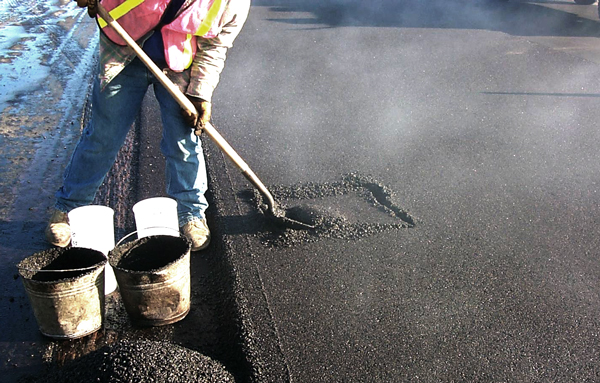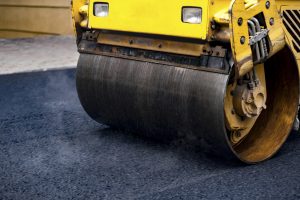Hot Mix Asphalt Paving: Your Gateway to Premium Angled Parking Solutions
Hot Mix Asphalt Paving: Your Gateway to Premium Angled Parking Solutions
Blog Article
Unlocking the Secrets of Warm Mix Asphalt Modern Technology
Discovering the midsts of warm mix asphalt modern technology discovers a globe where specific solutions and thorough procedures assemble to form our roadways and facilities. The combination of fillers, accumulations, and binders isn't simply a building task yet a critical orchestration of longevity and effectiveness. As we peer right into the elaborate dance of elements, a tapestry of durability and sustainability unfolds. Yet what exists underneath this surface of asphaltic mastery, and what secrets wait to be unveiled in the realm of leading advancements?
Significance of Hot Mix Asphalt
Warm Mix Asphalt plays a vital role in contemporary infrastructure advancement as a result of its toughness and cost-effectiveness. As the most commonly made use of paving material for roadways, highways, and car park, Warm Mix Asphalt supplies a variety of advantages that contribute to its relevance in building tasks. One key advantage is its capacity to withstand rush hour lots and extreme climate condition, supplying a long-lasting and trustworthy surface area for transport networks. Additionally, Hot Mix Asphalt is cost-efficient in both initial building and long-lasting upkeep, making it a recommended selection for many facilities jobs.
The durability of Hot Mix Asphalt stems from its composition, which consists of accumulations, binder, and filler materials that are thoroughly picked and blended to meet particular efficiency requirements. Generally, the value of Warm Mix Asphalt in infrastructure growth can not be underrated, as it continues to be a foundation of modern-day building techniques.
Components of Asphalt Mixes
The make-up of asphalt mixes includes carefully selected accumulations, binder, and filler materials that are critical for achieving details efficiency needs. Aggregates are the primary component of asphalt mixes, offering toughness and stability. These aggregates can be natural, such as crushed rock or smashed stone, or synthetic, like recycled materials from old sidewalks. The binder, generally bitumen or asphalt concrete, holds the accumulations with each other and provides versatility and longevity to the mix. The selection of the binder is crucial as it directly affects the mix's performance in various weather. Fillers, such as moisturized lime or Portland concrete, are made use of to enhance the mix's workability and aging resistance. Angled Parking.
The mix and percentage of these parts play a significant function in establishing the quality and efficiency of the asphalt mix. Designers meticulously develop the mix to fulfill specific needs, taking into consideration aspects like web traffic quantity, climate conditions, and sidewalk lifespan. Correct selection and harmonizing of aggregates, binder, and fillers are important for producing long lasting, long-lasting asphalt sidewalks.
Mixing and Production Strategies

Once the aggregates are chosen, the binder, frequently asphalt concrete, is included in bind the materials together. The binder's top quality and amount substantially influence the mix's toughness, resistance, and flexibility to environmental variables. Additionally, fillers like hydrated lime or Rose city concrete may be incorporated to enhance certain features of the asphalt mix, such as its workability or wetness resistance.
During production, the accumulations go to my site and binder are heated, normally between 250-325 ° F(121-163 ° C ), to facilitate blending and guarantee appropriate finishing of the accumulations. The mixing process has to be detailed to achieve a homogeneous combination that promotes the desired performance characteristics of the asphalt. Various strategies, such as set blending or drum mixing, are employed to accomplish constant and high-quality asphalt mixes for construction projects.
Factors Impacting Asphalt Efficiency
Elements influencing asphalt efficiency encompass a variety of variables that influence the sturdiness, durability, and overall quality of asphalt sidewalks. One essential variable is the high quality of products look at this site used in the asphalt mix. The kind and source of aggregates, the binder high quality, and the additives all play a substantial role in identifying the efficiency of the asphalt pavement. The rank of accumulations is important as it affects the mix's stability, resistance, and workability to breaking and rutting.

Ecological conditions likewise influence asphalt performance. Temperature level variants, dampness infiltration, and website traffic tons can all affect the structural integrity of the sidewalk. Style considerations, such as pavement density and drain, are necessary in making certain the lasting efficiency of the asphalt pavement. By thoroughly taking into consideration these designers, professionals and factors can optimize asphalt efficiency and enhance the life span of sidewalks.
Sustainable Practices in Asphalt Innovation

Additionally, the advancement of warm-mix asphalt (WMA) technologies has actually gotten traction over the last few years. WMA enables the production and positioning of asphalt blends at lower temperatures compared to standard hot-mix asphalt, leading to decreased energy intake and greenhouse gas discharges. The usage of porous asphalt blends can help minimize stormwater overflow concerns by enabling water to infiltrate with the sidewalk and into the ground, advertising natural water purification and charge processes. By carrying out these sustainable methods, the asphalt industry can add to building a much more environmentally pleasant and durable framework network.
Verdict
In verdict, warm mix asphalt modern technology plays an important function in modern-day framework growth as a result of its resilience and cost-effectiveness. By very carefully stabilizing parts, using correct blending strategies, and taking into consideration numerous variables, designers can produce top notch asphalt blends that stand up to hefty website traffic loads and harsh weather problems. Welcoming lasting methods, such as utilizing warm-mix technologies and recycled products, better boosts the environmental friendliness of asphalt technology.
Mixing and manufacturing techniques in hot mix asphalt modern technology entail the exact combination and handling of accumulations, binder, and fillers to produce a resilient and high-performance asphalt mix.Variables affecting asphalt performance incorporate a variety of variables that impact the resilience, long life, and general quality of asphalt sidewalks. Sustainable practices in asphalt modern technology encompass numerous efforts aimed at minimizing the environmental influence of asphalt manufacturing and paving processes. By incorporating recovered asphalt pavement (RAP) and recycled asphalt roof shingles (RAS) into brand-new asphalt mixes, the market can considerably reduce blog the usage of raw materials and energy, while additionally decreasing garbage dump waste.
WMA allows for the production and positioning of asphalt mixes at reduced temperatures contrasted to traditional hot-mix asphalt, resulting in minimized power usage and greenhouse gas exhausts.
Report this page